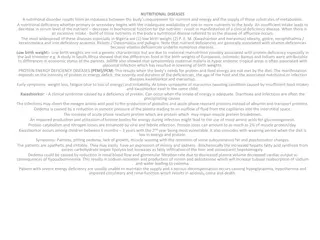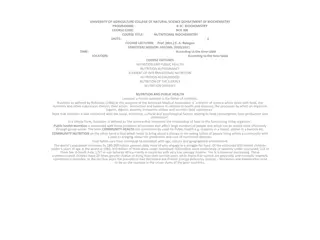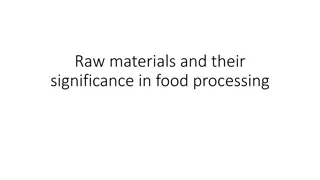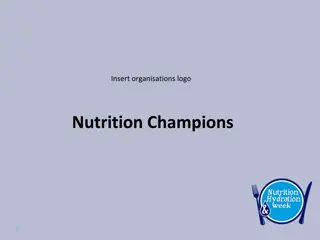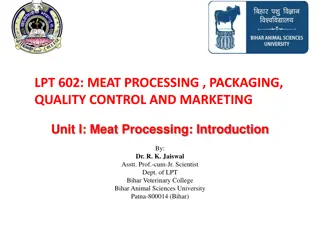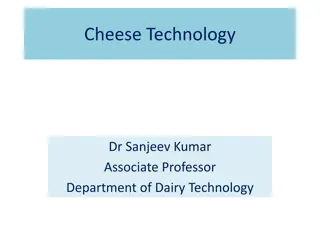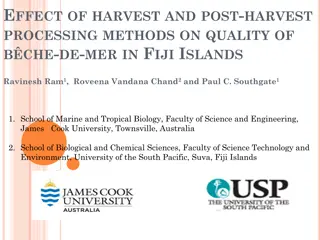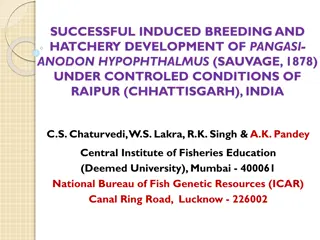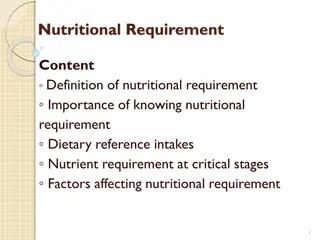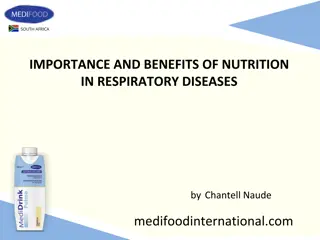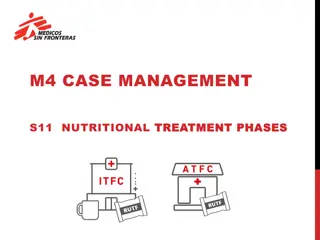Effect of Processing Methods on Catfish Nutritional Quality
Fish, particularly catfish, serves as a vital protein source in West Africa. This study examines the impact of different processing methods, including the use of preservatives like sodium citrate and black pepper, on the nutritional quality, microbial status, and sensory attributes of smoked catfish. Traditional smoke-drying techniques are explored as alternatives to cold storage due to challenges in power supply and equipment costs. The goal is to reduce post-harvest losses and enhance the overall quality of smoked catfish for consumption.
Uploaded on Sep 13, 2024 | 2 Views
Download Presentation

Please find below an Image/Link to download the presentation.
The content on the website is provided AS IS for your information and personal use only. It may not be sold, licensed, or shared on other websites without obtaining consent from the author.If you encounter any issues during the download, it is possible that the publisher has removed the file from their server.
You are allowed to download the files provided on this website for personal or commercial use, subject to the condition that they are used lawfully. All files are the property of their respective owners.
The content on the website is provided AS IS for your information and personal use only. It may not be sold, licensed, or shared on other websites without obtaining consent from the author.
E N D
Presentation Transcript
The Effect of Different Processing Methods on the Nutritional Quality and Microbiological Status of Cat Fish (CLARIAS LEZERA now (Clarias gariepinus) Oyarekua Mojisola Adenike, Department of Microbiology, Federal University, P.M.B 373 Oye- Ekiti, Nigeria,
INTRODUCTION Fish provides 30 to 80% of the total animal protein intake of West Africa people . Catfish is high in unsaturated fatty acids, vitamins, proteins, minerals, low in carbohydrates and saturated fat. Smoke-dried fish consumed in Nigerian has appetizing taste and flavour [2]. Catfish easily looses quality rapidly after catch. From literature some preservatives used are potassium sorbate, sodium chloride and sodium citrate. These preservatives can inhibit food-borne pathogens like Staphylococcus aureus, Escherichia coli, Listeria monocytogenes and toxin production of Clostridium botulinum . Black pepper (Piper guineenses) of beta-caryophyllene . contains compounds like piperine and large amounts In Nigeria it is used in making stew where it adds pungent aroma. The peppers have preservative and anti-oxidant properties .
Introduction contd The various kinds of woods in the tropics are suitable for fish smoking process. Heat from the smoke can reduce the water activity of the fish cells. resulting in microbial inhibition which minimises spoilage [4]. Smoking and the use of preservatives can influence the organoleptic attributes of fish . The antimicrobial effect of smoking depends on temperature, humidity, intensity of the smoke, duration, fish microflora and concentration of active components in the smoke [17].
JUSTIFICATION AND OBJECTIVE Epileptic power supply and high cost of equipment in Nigeria have made cold storage, canning and freezing non-realistic. Therefore traditional technique of smoke-drying is in common use but without preservative addition. The utilization of indigenous spices and chemicals like sodium citrate as catfish preservative properties has not been exploited in Nigeria Therefore preservation of smoked fish using chemical preservatives and spices has become imperative. This study assessed the effect of sodium citrate and black pepper (Piper guineenses) on proximate composition, microbial and organoleptic attributes of smoked catfish during a 6-week storage at ambient temperature. Also the outcome is expected to encourage reduction in post harvest losses and how to improve the nutritional and sensory attributes for consumption.
Methodology Fresh catfish (Clarias gariepinus) samples were selected, washed, eviscerated, washed with distilled water and paper towel dried and weighed. About 300ml distilled water was added to 20g each of ground black pepper and sodium citrate. Each mixture was boiled and refluxed for 5 minutes, filtered hot through a sterile cheese- cloth (300 ). The filtrate was cooled to room temperature (29 10C). A= Control smoked fillets only, B= fillets previously soaked in Sodium citrate extract before smoking C= Fillets soaked in black pepper extract before smoking D=Fillets smoked in combination of black pepper and sodium citrate extracts before smoking. All samples were soaked in warm (45 10C) spice extracts for 10 minutes, drained and smoke-dried by laying the fish samples over the smoking kiln at 1850C. uniform smoking was achieved by turning samples over at intervals of 15 minutes for 2 hours. Some of the smoked samples were stored at -20oC and analyzed for Proximate composition , Peroxide value (PV)and thiobarbituric acid (TBA)(for lipid oxidation) were all determined using methods of AOAC (2005) at day one(0), then at two, four and six weeks of storage. Shelf life studies Smoke-dried fish was packaged in sterile low-density polyethylene bag, and sealed. Samples were kept in cardboard waxed paper boxes and stored at room temperature (29 10C) for the shelf life study at day 0, weeks 2,4 and 6.
Methodology contd ii. Lipid oxidation was conducted using the peroxide value (PV) measurement .(as milliequivalent peroxide per kg of sample) Thiobarbituric acid (TBA) was determined by using UV spectrophotometer (and absorbance measured at 532nm per kg of fish sample. TBA value was expressed as milligram malonaldehyde/kg of sample Microbiological evaluation A 10g representative sample from smoked fish muscle dissolved in sterile distilled water was homogenized for 60 seconds and serial dilutions (10-1 10-3) made . One milliliter (1ml) of the diluents was pour-plated on nutrient agar and incubated at 30 C for 48hrs Total number of visible bacterial colonies, was determined by the Grid- Membrane Filtration method (GMFM) [25] The means of duplicate colony counts were calculated.
methodology contd iii Trained panellists evaluated the various samples The 5 point descriptive hedonic scale was used for taste, texture, aroma, colour and general acceptability of the samples at 5% level of significance Ranking scores were: like extremely(5), like moderately(4), neither like nor dislike (3), dislike moderately(2) and dislike extremely (1) respectively.
Statistical Analysis Measurements were carried out in triplicates. All microbial counts were converted into base-10 logarithms of colony forming units per g of sliced catfish samples (log10CFU/g). Data were subjected to analysis of variance (ANOVA) using the General Linear Models procedure of the Statistical Analysis System software of SAS Institute (SAS Institute, Inc., 1990). Differences among the mean values of the various treatments were determined by the least significant difference (LSD) test, and the significance was defined at p< 0.05. The differences which are equal to or more than the identified LSD values are considered statistically significant.
Table 1.effect of sodium citrate and black pepper treatments on moisture content (g/100g) of sliced catfish during six weeks storage 0 2 4 6 Time (weeks) 19.42a 0.01 20.41a 0.01 19.04a 0.03 15.13b 0.03 A=Control 10.12d 0.01 10.68d 0.01 13.06d 0.01 13.54d 0.03 B=NaC 16.23b 0.01 18.03b 0.02 18.01b 0.01 17.87a 0.01 C=Black pepper(Bp) 13.51c 0.01 15.02c 0.01 15.02c 0.01 14.64c 0.02 D=NaC+Bp
Table 2. effect of sodium citrate and black pepper treatments on protein content (g/100g) of sliced catfish during six weeks storage Sample 0 2 4 6 Time (weeks) 60.52d 0.01 61.34d 0.02 65.17a 0.03 69.13a 0.01 A=Control 69.30a 0.02 70.93a 0.05 66.08a 0.02 65.54b 0.02 B=NaC 65.34c 0.03 64.05c 0.03 63.84b 0.02 63.66c 0.01 C=Black pepper(Bp) 66.58b 0.01 66.15b 0.02 66.15a 0.02 65.54b 0.03 D=NaC=Bp
Protein content The increase in the protein content of the smoked catfish could be attributed to an increase in the dry matter content per unit of weight following sample dehydration during smoking this is in agreement to the finding of [28]. Storage time appeared not to have affected (p>0.05) the protein content of smoked catfish.
Table 3. Effect of Soodium citrate (NaC) and blsck pepper (pg) on fat content (g/100g) of sliced fish during six weeks storage Sample 0 2 4 6 Time (weeks) 16.66a 0.02 15.48a 0.01 12.05d 0.01 A=Control 12.44d 0.02 15.33c 0.02 14.51c 0.01 15.02a 0.02 15.00a 0.01 B=NaC 12.24d 0.02 14.17d 0.02 14.04c 0.02 17.87a 0.01 C= Black pepper(Bp) 13.51c 0.01 15.02c 0.01 15.02c 0.01 14.64c 0.02 D= NaC+Bp
Table 4.Effect of Sodium Citrate (NaC) and black pepper(pg) treatments on ash content (g/100g) of sliced fish during six weeks storage Sample 0 2 4 6 Time (weeks) 19.42a 0.01 20.41a 0.01 19.04a 0.03 15.13b 0.03 A=Control 10.12d 0.01 10.68d 0.01 13.06d 0.01 13.54d 0.03 B=NaC 16.23b 0.01 18.03b 0.02 18.01b 0.01 17.87a 0.01 C= Black pepper(Bp) 13.51c 0.01 15.02c 0.01 15.02c 0.01 14.64c 0.02 D= NaC+Bp
Figure 1: Effect of sodium citrate (NaC) and black pepper (Pg) treatments on lipid oxidation (peroxide value) in sliced catfish during six weeks storage Effect of sodium citrate and black pepper on lipid oxidation(PV) in sliced catfish during six weeks storage 10 9 8 7 6 PV(mg/Kg) A 5 B C 4 D 3 2 1 0 0 2 4 6 Storage Time (wks)
Peroxide Value The PV in all samples were below the acceptable level of 10 20 meq peroxide/kg fish fat[30]. This might be due to the extended storage and high temperature exposure Fatty fish are particularly vulnerable to lipid oxidation which can create unpleasant (rancid) taste, smell, alteration in color. The various reactions involved in the lipid oxidation are either non- enzymatic or catalyzed by microbial enzymes or by intracellular or digestive enzymes from the fish themselves.
Figure 2: Effect of sodium citrate (NaC) and black pepper (Pg) treatments on lipid oxidation (Thiobarbituric acid value) in sliced catfish during six weeks storage. Effect of sodium citrate and black pepper on lipide oxidation (TBAV) in sliced catfish during six weeks storage 2 1.8 1.6 1.4 A 1.2 NAC) AND TBA(mg/Kg) B 1 C 0.8 D 0.6 0.4 0.2 0 0 2 4 6 Storage Time (wks)
Thiobarbituric Acid Value All the TBA values obtained were significantly (p<0.05) increased with the storage time. However, samples B, C and D showed significantly (p<0.05) lower TBA values with the storage time, when compare with the control. TBA assay is a widely used indicator for the assessment of degree of lipid oxidation. The result of TBA assay corroborated that obtained by the PV. In this study, TBA values for all the samples were much lower than recommend limit 0.007mg/kg (7 g/kg) throughout the 6th week storage period. This is contrary to the values reported by [35].
Figure 3: Effect of different treatments on total aerobic plate count of catfish during six weeks storage. Effect of different treatments on total aerobic plate count of catfish during six weeks storage 7 6 5 TPC(log 10CFU/g) 4 A B 3 C D 2 1 0 0 2 4 6 Storage Time (wks)
Total Aerobic Plate Count of Microbes Sample C(with black had the least value while sample A (control) had the highest value. This indicated that dipping of the sliced catfish in the different treatment solutions resulted in drastic reduction of the initial TPC. The effects of preservatives on the microbial growth in fish may be depend on also on the degree of microbial contamination. By the end of 6th week of storage, TPCs for all of the different treatments were below 6 log10 CFU/g, while that of control attained a count of 6.24 log10 CFU/g. The control TPC is in close proximity to the maximal recommended limit of 7 log10 CFU/g for TPC in raw fish [36].
Table 6. Sensory Evaluation of Sliced Catfish during Six Weeks Storage Sample Colour Aroma Texture Taste General Acceptability 3.93d 0.38 3.58d 0.52 3.53d 0.57 3.62d 0.45 3.96d 0.66 A B 4.29c 0.72 3.73c 0.84 3.62c 0.95 4.38c 0.86 4.52c 0.63 C 4.37a 0.85 4.93b 0.49 4.77b 0.52 4.57b 0.74 5.74b 0.84 D 4.36a 0.87 5.40a 0.72 4.89a 0.64 5.89a 0.85 5.88a 0.73
Sensory Evaluation of Sliced Catfish during Six Weeks Storage There was significant (p<0.05) difference in the sensory attributes of all the samples assessed except in terms of color Might be due to individual variations among individuals in responding to the same level of stimuli. Sample D (with Nac+ Black pepper) was most preferred in terms of aroma, texture, taste while sample A (Control) was least preferred.
CONCLUSION From this study, sodium citrate and black pepper can be used as preservatives in smoked catfish without adversely affecting: quality in terms of lipid oxidation, microbial load color, and nutritional quality throughout 6 weeks of storage. There was significant (p>0.05) reduction in the PV and TBA values in comparison with the control. The effect of the spices applied singly and in combination on the catfish showed shelf life extension of all samples during the storage. The catfish samples exhibited shelf stability and the microbiological load fell within acceptable level stipulated by microbiological standards. This indicates that the samples might be safe for consumption throughout the period of 6 weeks storage.
ACKNOWLEDGEMEWNT Dr K Oni Food Science Department, Federal University, Oye-Ekiti, Nigeria.
FUTURE WORK Isolation and Identification of microorganisms associated with smoked fish using molecular methods Incorporation of treated smoked fish into fermented cereal as infants complementary food of adequate nutritional quality Co-fermentation of cereal/ legume/ fish fillets to produce infant complementary food of improved nutritional quality that can be affordable for low- socio economic mothers in Nigeria
REFERENCES 2. Nelson JS (2006) Fishes of the World. John Wiley & Sons, Inc., 2006; ISBN 0471250317. 4.Gram L (2001) Potential hazard in cold-smoked fish: Clostridium botulinum type E. In Processing Parameters Needed to Control Pathogens in Cold- smoked Fish.Especial Supplement to the Journal of Food Science 66(7): S- 1082-1087. 17. Erkan N (2004) Smoking Technology.In: Fish Processing Technology, Varlk,C.(ed.) Istanbul Univ. Fisheries Fac. Istanbul.
18. Kolodziejska I, Niecikowska C, Januszewska E and Sikorski ZE (2002) The microbial and sensory quality of mackerel hot smoked in mild conditions. Ledensm. Wiss.U Technol.35: 87- 92. 23. Williams SK, Rodrick GE, and West RL (1995) Sodium lactate affects shelf life and consumer acceptance of fresh catfish (Ictalurus nebulosus, marmoratus) fillets under simulated retail conditions. J. Food Sci. 60: 636-639. 25. Peterkin PI, Parrington LJ, and Sharpe, AN (1998) Determination of aerobic colony counts in foods by Hydrophobic Grid-Membrane Filtration (HGMF) method. Health Protection Branch, Ottawa, Canada. Government of Canada. Publishing Co., Inc. Lancaster, Pennsylvania. 2oC. J. Appl. Microbiol. 92 (4): 790-799. 28. Goktepe, I. and Moody, M.W.1998. Effect of modified atmosphere package on the quality of smoked catfish. Journal of Muscle Foods, 9:375-389.
30. Huss HH (1995) The effect of anaerobic conditions and carbon dioxide. In: Quality and Quantity changes in fresh fish. Technical paper no 348 :78-83 Rome: FAO Fisheries. 32. Connell JJ (1975) Contro offish quality. Fishing News (Books) Ltd. Farnham, Surrey UK. 33. Asiedu MS, Julshamn K, and Lie O (1991) Effect of local processing methods (cooking, frying, and smoking) on three fish species from Ghana: Part I, 35. Papadopoulos V, Chouliara I, Badeka A, Savaidis IN, Kontominas MG (2003) Effect of gutting on microbiological, chemical and sensory properties of aquacultured sea bass (Dicentrarchus labrax) stored in ice. Food Microbiology.20:411-420. 36. ICMSF International Commission on Microbiological Specification for Foods (1986) Microorganisms in Foods 2, Sampling for Microbiological Analysis. Principles and Specifications, (2nd edn), Oxford: Blackwell Science. 37. Emberg J, Laursen BG, Rathjen T and Dalgaard (2002) Microbial spoilage and formation of biogenic amines in fresh and thawed modified atmosphere-packed salmon (Salmo salar) at 2oC. J. Appl. Microbiol. 92 (4): 790-799.
APPRECIATION THANK YOU FOR YOUR ATTENTION!!!!!!



